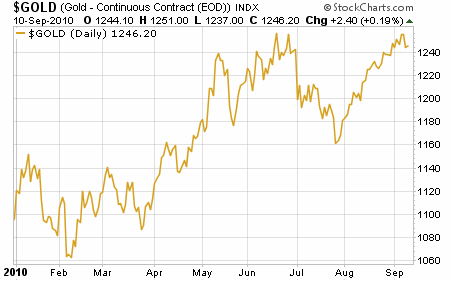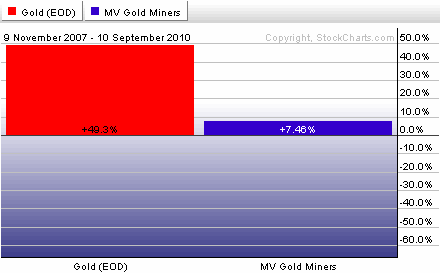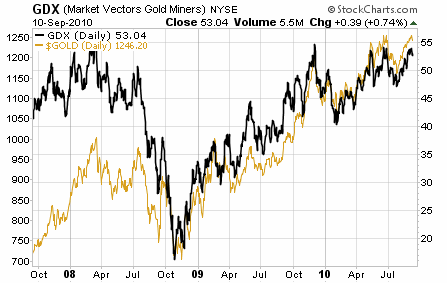-
Gold still $1000 off its inflation adjusted
highs -
Gold stocks falling behind – are you
buying? -
20-100 per cent upside if gold stays above
$1100
“Gold Loses Some Appeal”
That’s the headline from a story in
The Wall Street Journal just a few days ago, on September
10, 2010.
Gold dipped 0.4% on the Comex division of the New York
Mercantile Exchange to $1,246.50 an ounce.
That’s still close to the dollar denominated high of $1265
reached in June.
I just bought some physical gold during the dip back in
July, and I do plan on buying during future dips – but I wouldn’t recommend
buying gold necessarily at this point.
Even though the
yellow metal is about $1000 off its inflation-adjusted highs of $2251 reached
in 1980, I hesitate to recommend buying physical gold at these levels.
The good news is that there are plenty of gold securities
you can buy that are still relatively inexpensive. That’s because gold stocks
tend to lag gains made in the price of the underlying commodity.
I’ve been repeating the above statement for many months now,
but it’s true. Here’s a chart showing gains made in the price of gold (in
red) vs. gains made in the price of the largest gold stocks (in blue) between
1999 and 2007.
You can see how the bull market in gold over this period was
magnified nearly two-fold in gold stocks.
But since September
of 2007 gold stocks have been lagging gains made in the price of gold.
You can account for some of the under-performance by looking
at the huge sell-off in all stocks in 2008-2009. Since then, gold has nearly
doubled, while gold stocks are flat:
But $1200+ gold is hugely profitable for gold mining
companies. Most gold miners are profitable as long as gold is north of around
$600. That’s about the average amount of money it takes to mine and refine
one ounce of gold and bring it to market.
Anything over $600 is pure profit. That’s why gold miners
are able to multiply gains made in gold: their earnings go up by an
incremental factor over and above their costs of production.
A quick example:
If gold prices are $1000 an ounce, the average gold miner
makes $400 per ounce in profit. But if gold rises to $1200 an ounce, they
make $600 in profit, or 50% more! Gold rose 20%, and gold miners make 50%
more profit. That profit is eventually reflected in the stock price, but
there’s a lag.
The lag can be accounted for because of two reasons: it
takes time for gold miners to increase production to take advantage of
increasing prices, and most fundamental analysts (the guys who set price
targets on Wall Street) determine a stock’s price target based on the present
value of future cash flows – the stocks will move higher once these
increasing future cash flows become more reliable.
What’s the downside?
Gold miners take a commensurate hit when gold prices slide.
That increased profitability (future cash flows) can just as easily turn into
decreased profitability (lower future cash flows), and gold stocks tend to
get punished accordingly.
So, the trick is to find companies with the lowest
costs-per-ounce, and to buy them on dips after gold falls.
Right now, gold
stocks are severely lagging the gains made in gold’s price. If gold stays
above $1100, I expect gold stocks in general to move at least 25% in the next
six months. That’s not speculation, it’s simply where gold stocks should be
to catch up to gains in gold’s price. If they multiply gains in gold’s price
– as they typically have done over the past 10 years, then you’re looking at
a potential 100% gain, or a double.
That’s just the average gain. You can shoot for average by
simply buying the Market Vectors Gold Miners ETF (NYSE:
GDX). This ETF is comprised solely of the largest publicly traded
gold mining companies.
If you’re interested in an investment with a little more
upside, then I’d recommend taking a look at a company Chief Investment
Strategist Ian Wyatt recently added to his Small Cap Investor
Pro portfolio. It’s a small North American gold mining company
with one of the lowest costs-per-ounce of any gold miner: around $450.
But right now this company is trading at a substantial
discount to its gold reserves. Buying them today is like buying their gold in
the ground for less than $200 an ounce. Like most publicly traded gold
companies, they’re lagging gains made in gold’s price. Gold made 15% gains so
far this year, but Ian’s favorite gold stock is actually down 5%.
It’s a great time to be buying low cost gold producers.
You
can click here to read the rest of the story.
Good Investing,
Kevin McElroy
Editor
Resource Prospector
 Facebook
Facebook
 Twitter
Twitter



